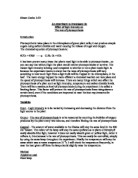Aim: To investigate the limiting effect of light intensity on photosynthesis.
Prediction: I predict that as the light source (desk lamp) is moved closer to the pondweed (Elodea), the rate of photosynthesis will increase therefore more oxygen will be produced creating more bubbles.
I believe this will happen
because when the light source is nearer to the plant more of the plants
surface area is coming in to contact with the light from the desk lamp
therefore more photosynthesis will occur which will mean more oxygen will be produced which will create more bubbles.
Plan:
Method:
I am going to collect my apparatus and set it up as in the diagram, then I am going to fill the beaker with water. I will then set up desk lamp in correct position (eg: 20cm away). I will cut a piece of elodea 5cm long with a Scapular and put it into the beaker of water. Before I turn on the desk lamp I will observe the amount of bubbles the Elodea produces with foil wrapped around the beaker and then again without the foil. I will do this for 1 minute. Then I will turn on the desk lamp and start the stop clock.
I will count the bubbles for the next minute and also make a note of the change in volume.
I will repeat this for a distance of 10cm, 5cm and 2cm away. I will record all my results in a table.







